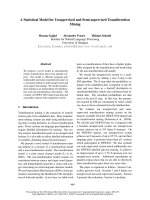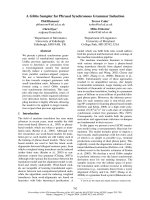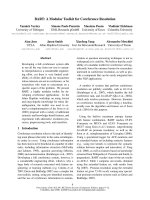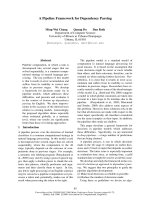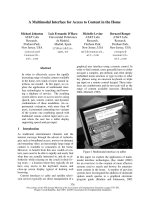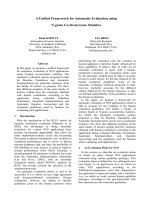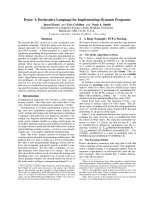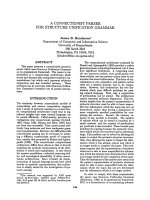Báo cáo khoa học: "A Computational Framework for Composition in Multiple Linguistic Domains" doc
Bạn đang xem bản rút gọn của tài liệu. Xem và tải ngay bản đầy đủ của tài liệu tại đây (226.03 KB, 3 trang )
A Computational Framework for Composition in Multiple
Linguistic Domains
Elvan GS~men
Computer Engineering Department
Middle East Technical University
06531, Ankara, Turkey
Abstract
We describe a computational framework
for a grammar architecture in which dif-
ferent linguistic domains such as morphol-
ogy, syntax, and semantics are treated not
as separate components but compositional
domains. The framework is based on
Combinatory Categorial Grammars and it
uses the morpheme as the basic building
block of the categorial lexicon.
1 Introduction
In this paper, we address the problem of mod-
elling interactions between different levels of lan-
guage analysis. In agglutinative languages, affixes
are attached to stems to form a word that may cor-
respond to an entire phrase in a language like En-
glish. For instance, in Turkish, word formation is
based on suffixation of derivational and inflectional
morphemes. Phrases may be formed in a similar
way (1).
(1)
Yoksul-la~-t~r-zl-makta-lar
poor-V-CAUS-PASS-ADV-PERS
'(They) are being made poor (impoverished)'.
In Turkish, there is a significant amount of in-
teraction between morphology and syntax. For in-
stance, causative suffixes change the valence of the
verb, mad the reciprocal suffix subcategorize the verb
for a noun phrase marked with the comitative case.
Moreover, the head that a bound morpheme modi-
fies may be not its stem but a compound head cross-
ing over the word boundaries, e.g.,
(2)
iyi oku-mu~ ~ocuk
well read-REL child
'well-educated child'
In (2), the relative suffix
-mu~
(in past form of
subject participle) modifies
[iyi oku]
to give the
scope
[[[iyi oku]mu~] 9ocuk].
If syntactic composi-
tion is performed after morphological composition,
we would get compositions such as
[iyi [okumu~
6ocuk]]
or
[[iyi okurnu~] ~ocuk]
which yield ill-formed
semantics for this utterance.
As pointed out by Oehrle (1988), there is no rea-
son to assume a layered grammatical architecture
which has linguistic division of labor into compo-
nents acting on one domain at a time. As a computa-
tional framework, rather than treating morphology,
syntax and semantics in a cascaded manner, we pro-
pose an integrated model to capture the high level of
interaction between the three domains. The model,
which is based on Combinatory Categorial Gram-
mars (CCG) (Ades and Steedman, 1982; Steedman,
1985), uses the morpheme as the building block of
composition at all three linguistic domains.
2 Morpheme-based Compositions
When the morpheme is given the same status as
the lexeme in terms of its lexical, syntactic, and
semantic contribution, the distinction between the
process models of morphotactics and syntax disap-
pears. Consider the example in (3).
(3)
uzun kol-lu g5mlek
long sleeve-ADJ shirt
Two different compositions 1 in CCG formalism
are given in Figure 1. Both interpretations are plau-
sible, with (la) being the most likely in the absence
of a long pause after the first adjective. To account
for both cases, the suffix
-lu
must be allowed to mod-
ify the head it is attached to (e.g., lb in Figure 1),
or a compound head encompassing the word bound-
aries (e.g., 1:~ in Figure 1).
3 Multi-domain Combination
Operator
Oehrle (1988) describes a model of multi-dimen-
sional composition in which every domain Di has
an algebra with a finite set of primitive operations
1Derived and basic categories in the examples are in
fact feature structures; see section 4.
We use ~ '~ to denote the combination of categories
x and y giving the result z.
302
lexical entry syntactic category semantic category
~z~n n/~ Ap.Zong(p( z ) )
kol n Ax.sleeve(x)
-l~ (~1~) \ n ~q.x~.~(y, ha~(q))
g5mlek n Aw.shirt(w)
uzun kol .In gJmlek
(la)
• n/n
shirt(y, has(long(sleeve(z))))
= 'a shirt with long sl '
(lb)
~z~n
kol -lu g6mlek
n/n
long(shirt(y, has(sleeve(z))))
= 'a long shirt with sleeves'
Figure 1: Scope ambiguity of a nominal bound mor-
pheme
Fi.
As indicated by Turkish data in sections 1 and 2,
Fi may in fact have a domain larger than but com-
patible with Di.
In order to perform morphological and syntactic
compositions in a unified framework, the slash oper-
ators of Categorial Grammar must be enriched with
the knowledge about the type of process and the
type of morpheme. We adopt a representation sim-
ilar to Hoeksema and Janda's (1988) notation for
the operator. The 3-tuple
<direction, morpheme
type, process type>
indicates direction 2 (left, right,
unspecified), morpheme type (free, bound), and
the type of morphological or syntactic attachment
(e.g., affix, clitic, syntactic concatenation, reduplica-
tion). Examples of different operator combinations
are given in Figure 2.
4 Information Structure and
Tactical Constraints
Entries in the eategorial lexicon have tactical con-
straints, grammatical and semantic features, and
phonological representation. Similar to HPSG (Pol-
lard and Sag, 1994), every entry is a signed
attribute-value matrix. Lexical and phrasal ele-
2We have not yet incorporated into our model the
word-order variation in syntax. See (Hoffman, 1992) for
a CCG based approach to this phenomenon.
Operator Morp.
< \, bound, clitic> de
< \, bound, affix>
-de
</, bound, redup>
ap-
</, free, concat>
nzun
< \, free, concat>
ba~ka
<[, free, concat>
gSr
Example
Ben de git-ti.m
I too go-TENSE-PERS
'I went too.'
Ben-de kalem ear
I-LOCATIVE pen exist
'I have a pen.'
ap-afzk durum
INT-clear situation
'Very clear situation'
uzun
yol
long road
'long
road'
bu- ndan ba~ka
this-ABLATIVE other
'other than this'
ktz kedi-yi gSr-dii
girl cat-ACC see-TENSE
or
ktz g6rdii kediyi
'The girl saw the cat'
Figure 2: Operators in the proposed model.
ments are of the following f (function) sign:
Fres ]
/LphonJ
res-op-arg
is the categorial notation for the ele-
ment. phon represents the phonological string. Lex-
ical elements may have (a) phonemes, (b) mete-
phonemes such as H for high vowel, and D for a dental
whose voicing is not yet determined, and (c) optional
segments, e.g.,
-(y)lA,
to model vowel/consonant
drops, in the phon feature. During composition,
the surface forms of composed elements are mapped
and saved in phon. phon also allows efficient lexicon
search. For instance, the causative suffix
-DHr has
eight different realizations but only one lexical entry.
Every res and arg feature has an f or p (property)
sign:
syn 1
pLSernj
syn and sere are the sources of grammatical (g
sign) and semantic (s sign) properties, respectively.
These properties include agreement features such as
person, number, and possessive, and selectional re-
303
strictions:
"cat
type
form
restr
<cond>
$
"person "
number
poss
nprop
case
relative
form
"reflexive
reciprocal
causative
passive
vprop
tense
modal
aspect
person
form
restr
<cond>
g
A special feature value called none is used for
imposing certain morphotactic constraints, and to
make sure that the stem is not inflected with the
same feature more than once. It also ensures,
through syn constraints, that inflections are marked
in the right order (cf., Figure 3).
5 Conclusion
Turkish is a language in which grammatical func-
tions can be marked morphologically (e.g., case),
or syntactically (e.g., indirect objects). Semantic
composition is also affected by the interplay of mor-
phology and syntax, for instance the change in the
scope of modifiers and genitive suffixes, or valency
and thematic role change in causatives. To model
interactions between domains, we propose a catego-
rial approach in which composition in all domains
proceed in parallel. As an implementation, we have
been working on the modelling of Turkish causatives
using this framework.
6 Acknowledgements
I would like to thank my advisor Cem Bozsahin for
sharing his ideas with me. This research is supported
in part by grants from Scientific and Technical Re-
search Council of Thrkey (contract no. EEEAG-
90), NATO Science for Stability Programme (con-
tract name TU-LANGUAGE), and METU Gradu-
ate School of Applied Sciences.
References
A. E. Ades and M. Steedman. 1982. On the order
of words. Linguistics and Philosophy, 4:517-558.
res
op
arg
sere
}hon
"]H"
res cat
n
r person none
number
none
possessive
none
syn nprop |case
none
|relative
none
Lform
common
type property ]
sere form h~ I~)j
op (/, free, concat)
syn
Lnprop [ form
com. or
prop.
Lsem r type
]
L f°rm
~]ntity
)hob
\, bound, suffix)
cat n
F person none
number
singular
possessive none
syn nprop |case
none
/relative
none
Lform
common
!formtype &ntity]
Figure 3: Lexicon entry for -lH.
Jack Hoeksema and Richard D. Janda. 1988. Im-
plications of process-morphology for categorial
grammar. In R. T. Oehrle, E. Bach, and D.
Wheeler, editors, Categorial Grammars and Nat-
ural Language Structures, D. Reidel, Dordrecht,
1988.
Beryl Hoffman. 1992. A CCG approach to free word
order languages. In Proceedings of the 30th An-
nual Meeting of the A CL, Student Session, 1992.
Richard T. Oehrle. 1988. Multi-dimensional compo-
sitional functions as a basis for grammatical anal-
ysis. In R. T. Oehrle, E. Bach, and D. Wheeler,
editors, Categorial Grammars and Natural Lan-
guage Structures, D. Reidel, Dordrecht, 1988.
C. Pollard and I. A. Sag. 1994. Head-driven Phrase
Structure Grammar. University of Chicago Press.
M. Steedman. 1985. Dependencies and coordination
in the grammar of Dutch and English. Language,
61:523-568.
304

